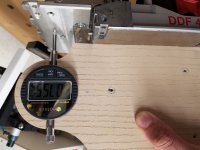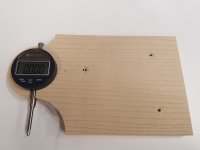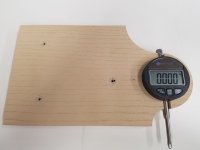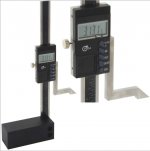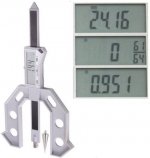So, I already know Dominos and Dowels dont "have" to be centered. However there are times when it is needed or useful. In my need to make room for other toys in the shop. I need to get rid of my doweling bench with the pneumatic clamps I had posted in other threads. So, I needed to be able to accurately center my dowels and have a precise dimension off of the one side since I end drill with the ddf40 and it needs to match the holes I drill on the face with the cnc using the fence. It also comes in handy if you build exposed domino drawers. Either way I know some have expressed interest in the best way and I think I have found it. I used to use the depth rod on a caliper before but the Mafell has a gap and chamfer on the fence next to the face so its hard to get the depth rod to land on enough surface to get a good measurement.
So, I made this holder for a digital dial gauge. The digital works better for this as you can zero it when compressed and get a measurement as it falls which is what you need for setting the fence on either machine. I made the holder universal so you can flip the dial indicator over to measure while its being extended or compressed.
The formula is pretty easy. Take the material thickness and divide by 2 = X Then take the distance from the bottom of the plate to the center of the cutter (10mm for domino and 9.5 or .374" for the DDF40) and add that to X = What the dial should read. First test cut I read .001 difference from one side to the other. So, about .0005" error. Figured I could live with that so left it alone. I used 8mm tool steel rod inserted into 8mm dowel holes with a 123 block to take the measurement. Seeing as how the fence is out .003 on my ddf40 from the left to right side, That's easily within tolerance for me.
Now that I'm typing this it occurred to me to reverse it so the dial reads while being compressed and make a smaller dial holder that could be clamped onto the fence instead and the indicator would measure on the base. It would make it slightly easier as it would free up one hand instead of using one to hold it onto the dial holder. Oh well, v.2.0 I guess.
So, I made this holder for a digital dial gauge. The digital works better for this as you can zero it when compressed and get a measurement as it falls which is what you need for setting the fence on either machine. I made the holder universal so you can flip the dial indicator over to measure while its being extended or compressed.
The formula is pretty easy. Take the material thickness and divide by 2 = X Then take the distance from the bottom of the plate to the center of the cutter (10mm for domino and 9.5 or .374" for the DDF40) and add that to X = What the dial should read. First test cut I read .001 difference from one side to the other. So, about .0005" error. Figured I could live with that so left it alone. I used 8mm tool steel rod inserted into 8mm dowel holes with a 123 block to take the measurement. Seeing as how the fence is out .003 on my ddf40 from the left to right side, That's easily within tolerance for me.
Now that I'm typing this it occurred to me to reverse it so the dial reads while being compressed and make a smaller dial holder that could be clamped onto the fence instead and the indicator would measure on the base. It would make it slightly easier as it would free up one hand instead of using one to hold it onto the dial holder. Oh well, v.2.0 I guess.

